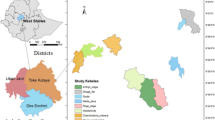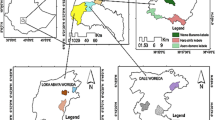Abstract
The majority of studies in agroforestry have primarily focused on boosting agricultural production, income generation, component interaction and less emphasized on the aspect of biodiversity. Several studies have called for more investigation to address the lack of understanding regarding the significance of agroforestry in conservation of plant biodiversity. This paper examined the role of agroforestry practices in conservation of perennial plant species diversity and the relationship that the perennial plant species diversity has with altitude, slope, and household wealth status. Data was collected from 216 sample plots of agroforestry practices using a multi-stage sampling system. The relationship between diversity indices and explanatory variables such as agroforestry practices, household wealth, altitude, and slope gradients were assessed using a generalized linear mixed model. The impact of these variables on plant species composition was evaluated using the Adonis2 function. Sorenson dissimilarity measures were used to determine the dissimilarities in species composition. A total of 135 perennial plant species with 58 families were identified, with natives accounting 68.15% of the total. The Fruit-tree-based agroforestry practices maintained significantly higher observed and expected number of species (p < 0.05). The values of the mean species richness, Shannon diversity, and Margalef indices per plot, were found to be 6.1 ± 0.65, 1.53 ± 0.32 and 6.37 ± .045 respectively. The dissimilarity in species composition between the two agroforestry practices was 0.53 while the Sorensen multiple-site dissimilarity measures among the kebeles was 0.72. The coffee-shade-tree based agroforestry practices deserved higher importance value index of species. The species richness, Shannon diversity and the importance value indices were significantly differed with respect to slope, altitude, agroforestry practices and household wealth status (p < 0.001). The species composition varied along altitudinal gradients, household wealth status and across the study kebeles (p = 0.005, 0.013, and 0.029, respectively). Finally, it is argued that agroforestry practices should be given more emphasis as a way of perennial plant species reservoirs in relation to the various socioeconomic and ecological factors in order to counterbalance the local threat of perennial plant species from their natural habitats.






Similar content being viewed by others
Notes
The lowest administrative unit in Ethiopia.
References
Abebe T, Sterck FJ, Wiersum KF, Bongers F (2013) Diversity, composition and density of trees and shrubs in agroforestry homegardens in Southern Ethiopia. Agrofor Syst 87:1283–1293. https://doi.org/10.1007/s10457-013-9637-6
Asigbaase M, Sjogersten S, Lomax BH, Dawoe E (2019) Tree diversity and its ecological importance value in organic and conventional cocoa agroforests in Ghana. PLoS ONE 14:66. https://doi.org/10.1371/journal.pone.0210557
Baselga A (2010) Partitioning the turnover and nestedness components of beta diversity, pp 134–143. https://doi.org/10.1111/j.1466-8238.2009.00490.x
Bekele-tesemma A (2007) Useful trees and shrubs of Ethiopia: identification, propagation and management for 17 agroclimatic zones
Betemariyam M, Negash M, Worku A (2020) Comparative analysis of carbon stocks in home garden and adjacent coffee based agroforestry systems in Ethiopia. Small-Scale For 19:319–334. https://doi.org/10.1007/s11842-020-09439-4
Birhane E, Ahmed S, Hailemariam M, Negash M (2020) Carbon stock and woody species diversity in homegarden agroforestry along an elevation gradient in southern. Agrofor Syst 4:66. https://doi.org/10.1007/s10457-019-00475-4
Colwell RK, Chao A, Gotelli NJ et al (2012) Models and estimators linking rarefaction, extrapolation and comparison of assemblages. J Plant Ecol 5:3–21. https://doi.org/10.1093/jpe/rtr044
Curtis JT, McIntosh RP (1950) The interrelations of certain analytic and synthetic phytosociological characters. Ecology 31:434–455
Dobrovolski R, Melo AS, Cassemiro FAS, Diniz-filho JAF (2012) Climatic history and dispersal ability explain the relative importance of turnover and nestedness components of beta diversity. Glob Ecol Biogeogr 21:191–197. https://doi.org/10.1111/j.1466-8238.2011.00671.x
Duguma LA, Hager H (2010) Woody plants diversity and possession, and their future prospects in small-scale tree and shrub growing in agricultural landscapes in central highlands of Ethiopia. Small-Scale For 9:153–174. https://doi.org/10.1007/s11842-009-9108-0
Erenso M, Abebe W (2014) Floristic composition, diversity and vegetation structure of woody plant communities in Boda dry evergreen Montane Forest, West Showa, Ethiopia. Int J Biodivers Conserv 6:382–391. https://doi.org/10.5897/IJBC2014.0703
Fontana V, Guariento E, Hilpold A et al (2020) Species richness and beta diversity patterns of multiple taxa along an elevational gradient in pastured grasslands in the European Alps. Sci Rep 10:1–11. https://doi.org/10.1038/s41598-020-69569-9
Gebre AB, Birhane E, Gebresamuel G et al (2019) Woody species diversity and carbon stock under different land use types at Gergera watershed in eastern Tigray, Ethiopia. Agrofor Syst 93:1191–1203. https://doi.org/10.1007/s10457-018-0226-6
Gotelli NJ (2013) Measuring and estimating species richness, species diversity, and biotic similarity from sampling data. Elsevier, Amsterdam
Gyawali B, Thapa B, Neupane J, Thapa T (2022) Factors affecting distribution and habitat association of Red Panda in Bhojpur District, Nepal
Hadgu KM, Rossing WAH, Kooistra L, van Bruggen AHC (2009) Spatial variation in biodiversity, soil degradation and productivity in agricultural landscapes in the highlands of Tigray, northern Ethiopia. Food Secur 1:83–97. https://doi.org/10.1007/s12571-008-0008-5
Haile G, Lemenih M, Senbeta F, Itanna F (2017) Plant diversity and determinant factors across smallholder agricultural management units in Central Ethiopia. Agrofor Syst 91:677–695. https://doi.org/10.1007/s10457-016-0038-5
Hari V, Pathak A, Koppa A (2021) Dual response of Arabian Sea cyclones and strength of Indian monsoon to Southern Atlantic Ocean. Clim Dyn 56:2149–2161. https://doi.org/10.1007/s00382-020-05577-9
Harrison S, Ross SJ, Lawton JH, Ross J (2013) Beta Diversity on Geographic Gradients in Britain. J Anim Ecol 61:151–158
Kent M, Coker A (1992) Vegetation description and analysis: a practical approach. Wiley, Chichester, p 363
Lemessa D, Mewded B, Alemu S (2022) Woody species composition and recruitment structures of four common species in an arid and semi-arid ecosystem of Ethiopia. J Glob Ecol Environ 14:18–27
Magurran AE (2004) Measuring biological diversity. Blackwell, New York
Manish K (2021) Species richness, phylogenetic diversity and phylogenetic structure patterns of exotic and native plants along an elevational gradient in the Himalaya. Ecol Process 10:66. https://doi.org/10.1186/s13717-021-00335-z
McNeely JA, Schroth G (2006) Agroforestry and biodiversity conservation—traditional practices, present dynamics, and lessons for the future. Biodivers Conserv 15:549–554. https://doi.org/10.1007/s10531-005-2087-3
Mebrate A, Kippie T, Zeray N (2021) Determinant factor of plant species diversity in the organic agriculture-dominated system of Gedeo Zone, Southern Ethiopia
Negash M, Yirdaw E, Luukkanen O (2012) Potential of indigenous multistrata agroforests for maintaining native floristic diversity in the south-eastern Rift Valley escarpment, Ethiopia. Agrofor Syst 85:9–28. https://doi.org/10.1007/s10457-011-9408-1
Nepali BR, Skartveit J, Baniya CB (2021) Impacts of slope aspects on altitudinal species richness and species composition of Narapani-Masina landscape, Arghakhanchi, West Nepal. J Asia-Pac Biodivers 14:415–424. https://doi.org/10.1016/j.japb.2021.04.005
Pittarello M, Lonati M, Enri SR, Lombardi G (2020) Environmental factors and management intensity a ff ect in di ff erent ways plant diversity and pastoral value of alpine pastures. Ecol Indic 115:106429. https://doi.org/10.1016/j.ecolind.2020.106429
Rana D, Kapoor KS, Samant SS, Bhatt A (2020) Plant species conservation priority index for preparing management strategies: a case study from the Western Himalayas of India. Small-Scale For 19:461–481. https://doi.org/10.1007/s11842-020-09447-4
Reppin S, Kuyah S, de Neergaard A et al (2019) Contribution of agroforestry to climate change mitigation and livelihoods in Western Kenya. Agrofor Syst 94:203–220. https://doi.org/10.1007/s10457-019-00383-7
Rodenburg J, Mollee E, Coe R, Sinclair F (2022) Global analysis of yield benefits and risks from integrating trees with rice and implications for agroforestry research in Africa. For Crop Res 281:108504. https://doi.org/10.1016/j.fcr.2022.108504
Schmitt-Harsh M, Evans TP, Castellanos E, Randolph JC (2012) Carbon stocks in coffee agroforests and mixed dry tropical forests in the western highlands of Guatemala. Agrofor Syst 86:141–157. https://doi.org/10.1007/s10457-012-9549-x
Sharma V, Nath L, Ole R (2015) species diversity between farmland and forest in mid-hills of central Himalaya. Biodivers Conserv. https://doi.org/10.1007/s10531-015-0927-3
Sinclair F, Wezel A, Mbow C, et al (2019) Background paper the contribution of agroecological approaches to realizing climate, p 46
Snowdon P, Raison J, Keith H et al (2002) Protocol for sampling tree and stand biomass. Tech Rep. https://doi.org/10.13140/RG.2.1.2825.8967
Tadesse E, Negash M, Asfaw Z (2021) Impacts of traditional agroforestry practices, altitudinal gradients and households’ wealth status on perennial plants species composition, diversity, and structure in south-central Ethiopia. Agrofor Syst 95:1533–1561. https://doi.org/10.1007/s10457-021-00659-x
Tegene AS, Gamo FW, Cheche SS (2018) Woody vegetation composition, structure, and community types of Doshke Forest in Chencha, Gamo Gofa Zone, Ethiopia. Int J Biodivers 2018:1–16. https://doi.org/10.1155/2018/4614790
Teketay D, Tegineh A (1991) Traditional tree crop based agroforestry in coffee producing areas of Harerge, Eastern Ethiopia. Agrofor Syst 16:257–267. https://doi.org/10.1007/BF00119322
Teshome H, Tesfaye K, Dechassa N et al (2022) Analysis of past and projected trends of rainfall and temperature parameters in eastern and western Hararghe Zones, Ethiopia. Atmosphere. https://doi.org/10.3390/atmos13010067
Udawatta RP, Rankoth LM, Jose S (2019) Agroforestry and biodiversity. Sustain 11:66. https://doi.org/10.3390/su11102879
Wani ZA, Negi VS, Bhat JA et al (2023) Elevation, aspect, and habitat heterogeneity determine plant diversity and compositional patterns in the Kashmir Himalaya. Front For Glob Chang. https://doi.org/10.3389/ffgc.2023.1019277
Woldeamanual W, Asfaw Z, Lemessa D (2018) The effect of the surrounding landscape and socioeconomic characteristics on woody species diversity in homegardens of Shewarobit District, Northeast Ethiopia. Small-Scale For 17:471–483. https://doi.org/10.1007/s11842-018-9398-1
Woldu Z, Belew D, Benti T (2015) The coffee-khat interface in Eastern Ethiopia: a controversial land use and livelihood change scenario. J Agric Sci Technol B 5:149–169. https://doi.org/10.17265/2161-6264/2015.03.001
Yinebeb M, Lulekal E, Bekele T, Lemessa D (2022) Homegardens plant species richness and their use types have positive associations across agricultural landscapes of Northwest Ethiopia. Glob Ecol Conserv 40:e02342. https://doi.org/10.1016/j.gecco.2022.e02342
Zhang C, Li X, Chen L et al (2016) Effects of topographical and edaphic factors on tree community structure and diversity of subtropical mountain forests in the Lower Lancang River Basin. Forests. https://doi.org/10.3390/f7100222
Zhao Z, He L, Li G et al (2023) Partitioning beta diversity of dry and hot valley vegetation in the Nujiang River in Southwest China. Front Ecol Evol. https://doi.org/10.3389/fevo.2023.1199874
Zomer RJ, Neufeldt H, Xu J et al (2016) Global tree cover and biomass carbon on agricultural land: the contribution of agroforestry to global and national carbon budgets. Nat Publ Gr. https://doi.org/10.1038/srep29987
Acknowledgements
We thank the Ethiopian Ministry of education for financial support with the host of Hawassa University. We are grateful to the farmers of the study sites for allowing us to their farms during data collection. We are especially grateful to Oda Bultum University for offering a postgraduate study opportunity for the first author. Our special thanks go to Dr. Debissa Lemessa and Mr. Mohammedsultan Ahmed who were cooperative enough in handling the R software and GIS programs, respectively. Thanks also go to all those experts especially Girma Mesfin who was fully devoting his time during the whole data collection process.
Author information
Authors and Affiliations
Contributions
Conceptualization of the research idea was made by Muktar Reshad, the design and methodology were formulated by Mr. Muktar Reshad, Dr. Zebene Asfaw and Professor Muktar Mohammed, and the Formal analysis and investigation by Muktar Reshad; Original draft preparation: was by Muktar Reshad; All authors reviewed the manuscript and approved the final one.
Corresponding author
Ethics declarations
Conflict of interest
The authors declare that they have no conflicts of interest.
Additional information
Publisher's Note
Springer Nature remains neutral with regard to jurisdictional claims in published maps and institutional affiliations.
Supplementary Information
Below is the link to the electronic supplementary material.
Rights and permissions
Springer Nature or its licensor (e.g. a society or other partner) holds exclusive rights to this article under a publishing agreement with the author(s) or other rightsholder(s); author self-archiving of the accepted manuscript version of this article is solely governed by the terms of such publishing agreement and applicable law.
About this article
Cite this article
Reshad, M., Asfaw, Z. & Mohammed, M. Perennial plant species diversity and its socio-ecological determinants in selected agroforestry practices at eastern escarpments of Chercher Massive, Ethiopia. Agroforest Syst 97, 1627–1643 (2023). https://doi.org/10.1007/s10457-023-00884-6
Received:
Accepted:
Published:
Issue Date:
DOI: https://doi.org/10.1007/s10457-023-00884-6




